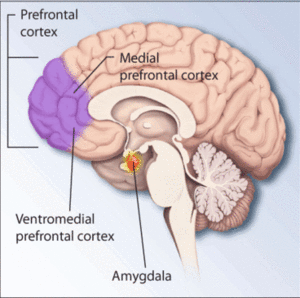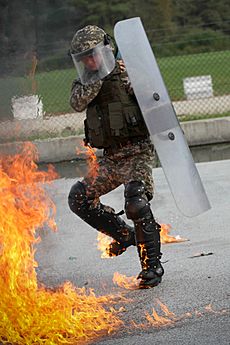Phobia facts for kids
A phobia (from the Greek φόβος, meaning "fear" or "morbid fear") is a strong fear about a specific thing or situation. In psychology, phobia is considered an anxiety disorder. Phobia is different than just being scared of something. The fear is so strong that it affects, and often damages, the sufferer's life. For example, the person will usually do everything they can to avoid the thing they fear. If they cannot avoid that thing, they will suffer from very strong anxiety which can damage their social relationships, their ability to work, and other areas of their everyday life.
There are two basic types of phobias: specific phobias and social phobias. People with specific phobias fear a certain thing, like spiders (this is called arachnophobia) or high places (acrophobia). People with social phobias fear social situations (like speaking in public, being in crowded areas, or being around other people).
Contents
Difference between phobia and fear
Fear is a normal human emotion. A phobia is different from normal fear in many ways:
- With phobias, a person fears something which is not really dangerous, or which is not anywhere near as dangerous as the person believes it is. For example, many humans fear spiders. However, a person with a phobia of spiders might panic when even thinking about a spider, refuse to leave home because they are too afraid of seeing a spider, or spend hours of each day making sure there are no spiders in their home. People with phobias realize that their anxiety is much more severe than normal fear would be.
- Phobia lasts much longer than regular fear. For example, a person with a phobia of spiders might continue to feel severe anxiety for hours after seeing a spider.
- When a person feels normal fear, their fear does not damage their life. Phobias cause problems in sufferers' daily lives. For example, they may damage important relationships or make it difficult for the person to work. People with social phobias may avoid being with other people or meeting new people.
It is hard to tell how many people suffer from phobias. Researchers think that between 5 and 13 percent of people seem to have a phobia. Women suffer from phobias about twice as often as men.
Causes and risk factors
Causes and risk factors phobias is very.
Caused
It can be caused by:
- phobia occurs mostly in childhood
- innate fear
- traumatic event (assault, assault witness, injury ...)
- hear about the possible danger (someone attacked animal; hear about a natural disaster ...)
Risk factors
- family influence and culture
- psychological personality disorder
- a characteristic trait – persons with a susceptible nature are more prone to phobias
- parents' lack of interest
- gender – women are more prone to phobias
Types of phobias
Specific phobias
also psychological phobias. These include hundreds of types phobias. Some:
- Aichmophobia - fear of sharp objects (like scissors or needles)
- Bacillophobia - fear of bacteria
- Claustrophobia - fear of small, closed-in spaces
- Necrophobia - fear of death
- Pharmacophobia - fear of medications
- Taphophobia - fear of being buried alive
- Blood-Injection-Injury phobias
- Zoophobias - fear of one, several, or all animals. Specific phobias of animals include Arachnophobia (fear of spiders), Cynophobia (fear of dogs), Entomophobia (fear of insects), Ophidiophobia (fear of snakes), and Scoleciphobia (fear of worms)
Social phobias
- Sociophobia - fear of people and/or social situations
- Glossophobia – fear of speaking in public
Symptoms
When a person with a phobia is exposed to their fear (encounters with the stimulus, think of it, sees the object of fear in the picture...) occur at these physical and psychological symptoms. Intensity depends on the degree of fear.
Psychological symptoms
Psychological symptoms are symptoms that take place within a human. These include the:
- anxiety up to panic
- want to run away
- shaking or tremors
- fear that the loss of their control, or to drive crazy
- fear of death
- fear of loss of consciousness
- nervousness, restlessness
Physical symptoms
- difficulty breathing, shortness of breath
- heart beat, increased heart rate
- shaking or tremors
- more sweating
- malaise, feeling sick
- weakness up to fainting
- rush hot or cold
- dry mouth
- pain or spin head
- a need to go to the toilet
Treatment
There are different ways to help people with phobias. There is treatment available; it focuses on making the patient less sensitive to the fear they suffer from, or showing him or her how the cycle of fear works. There is also medication available (mostly sedatives) that help people cope. Finally there are self-help groups.
See also
 In Spanish: Fobia para niños
In Spanish: Fobia para niños




